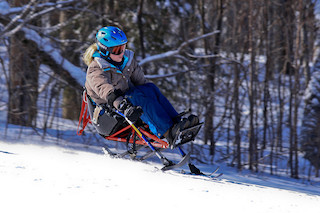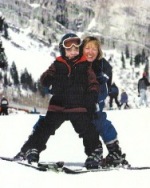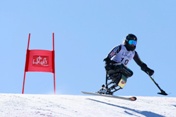Adaptive Skiing
Gear Considerations
For more information, see the links in the Resources section near the bottom of this page.
Types of Adaptive Skis & Equipment

-
Outriggers are metal elbow crutches with small skis on
the end of them. These adaptive ski poles provide extra points of contact
with the snow.
- Outriggers are used with mono-skis and bi-skis to help with balance and support.
- A mono-ski is a sit-down ski with one ski blade.
- A mono-ski is designed to be skied independently.
- A mono-ski is used with hand-held outriggers.
- A bi-ski is a sit-down ski with two ski blades.
- A bi-ski can be skied with the help of a partner
using tethers that are attached to the back of the bi-ski.
- Skiers turn by moving their head and shoulders.
- A bi-ski is used with a combination of hand-held
outriggers and tethers that are attached to the back of the bi-ski.
- Skiers turn by using the hand-held outriggers.
- A bi-ski can be skied with the help of a partner
using tethers that are attached to the back of the bi-ski.
-
Tethers can be used in either stand-up skiing or with a
bi-ski.
- In stand-up skiing, tethers, or reigns, are used to assist leg strength to help in stopping and/or steering the skis.
- The tethers are attached to a fixed ski bra, or strap, that is placed on the tips of both skis.
- A teacher will ski behind the skier with a tether in each hand.
If or when skiers are able to be more independent in their skiing, their equipment needs could change. For instance, they may progress from skiing with tethers to skiing without tethers, whether in a mono-ski, a bi-ski, or as a standing skier.
If the individual’s condition is progressive, the skier may require more adaptations to ski. The adaptive ski program will watch the skier and help with necessary changes as they progress.
Getting Started
Many people may choose adaptive skiing because they have balance, mobility, or strength issues but mostly for fun. A primary care doctor may not know the right gear that would be needed for skiing but would likely see the need for adaptations and could provide a referral to an adaptive ski program.
The primary care doctor may refer people with these health care needs:
- Spinal cord injury
- Spina bifida
- Cerebral palsy
- Debilitating muscular disease
- Amputation
- Visual impairment
- Rare disorders, such as Hunter or Hurler syndromes, that could impede mobility or balance
- Autism spectrum disorder
- Developmental delay
- Seizure disorder
The adaptive skiing program will look at the needs of the skier and find the most useful ski gear. Also, the adaptive ski program will help them make goals, see progress, and reassess any need for changes in equipment.
The primary care clinician may follow up with the adaptive ski program.
Use and Care
The adaptive ski program will teach the skier about use and care of the equipment. Use the following steps to stay safe and comfortable while skiing:
- The person should check with their primary care clinician before joining an adaptive ski program or skiing on their own.
- The ski gear should be checked with each use for fit, safety, and needs of the skier.
- The skier should tell the teacher about any discomfort from the gear that could cause skin irritation or bruising.
- Temperature should be watched closely in people with temperature regulation issues.
- The skier should call their medical home for any
non-emergency issue after skiing.
- If emergency care is needed while skiing, the adaptive ski program will arrange for care.
Funding and Costs
Adaptive skiing can be expensive. Most adaptive ski programs offer scholarships for their students. The program will usually have coaching and gear. Some skiers may choose to buy their own equipment, but need to remember that upkeep can be costly. Health plans do not often cover adaptive skiing lessons or gear.
Resources
Information & Support
For Parents and Patients
National Ability Center
The National Ability Center empowers individuals of all abilities by building self-esteem, confidence and lifetime skills
through sport, recreation and educational programs. Located in Park City, Utah; serves people from all over the country.
The National Center on Health, Physical Activity and Disability (NCHPAD)
The NCHPAD identifies recreational resources for people with disabilities both nationally and internationally. Resources include
organization directories, accessible recreation programs and facilities, adaptive equipment vendors, and links to journal
articles, books, videos, and more. Fact sheets are available on a variety of activities for people with disabilities, fitness
professionals, health professionals, and researchers.
Adaptive Exam Guide
An official guide, with detailed information, for adaptive ski instructors. Appendix #4 contains descriptions of equipment.
Services for Patients & Families Nationwide (NW)
| Service Categories | # of providers* in: | NW | Partner states (4) (show) | | NM | NV | RI | UT | |
|---|---|---|---|---|---|---|---|---|---|
| Adaptive Sports | 8 | 21 | 16 | 26 | 50 | ||||
| Assistive Technology Equipment | 36 | 47 | 46 | 44 | 72 | ||||
For services not listed above, browse our Services categories or search our database.
* number of provider listings may vary by how states categorize services, whether providers are listed by organization or individual, how services are organized in the state, and other factors; Nationwide (NW) providers are generally limited to web-based services, provider locator services, and organizations that serve children from across the nation.
Helpful Articles
Laskowski ER.
Snow skiing for the physically disabled.
Mayo Clin Proc.
1991;66(2):160-72.
PubMed abstract
An overview of the origin and benefits of adaptive skiing.
Barbin JM, Ninot G.
Outcomes of a skiing program on level and stability of self-esteem and physical self in adults with spinal cord injury.
Int J Rehabil Res.
2008;31(1):59-64.
PubMed abstract
Improved self-esteem and self-worth in participants in adaptive skiing program.
Sterba JA.
Adaptive downhill skiing in children with cerebral palsy: effect on gross motor function.
Pediatr Phys Ther.
2006;18(4):289-96.
PubMed abstract
Improved motor function after a 10-week skiing intervention.
Nasuti G, Temple VA.
The risks and benefits of snow sports for people with disabilities: a review of the literature.
Int J Rehabil Res.
2010;33(3):193-8.
PubMed abstract
Johnson CC.
The benefits of physical activity for youth with developmental disabilities: a systematic review.
Am J Health Promot.
2009;23(3):157-67.
PubMed abstract
Authors & Reviewers
| Author: | Lynn Foxx Pease |
| Reviewers: | Abby Dumas |
| Tina Persels |
Page Bibliography
Barbin JM, Ninot G.
Outcomes of a skiing program on level and stability of self-esteem and physical self in adults with spinal cord injury.
Int J Rehabil Res.
2008;31(1):59-64.
PubMed abstract
Improved self-esteem and self-worth in participants in adaptive skiing program.
Johnson CC.
The benefits of physical activity for youth with developmental disabilities: a systematic review.
Am J Health Promot.
2009;23(3):157-67.
PubMed abstract
Laskowski ER.
Snow skiing for the physically disabled.
Mayo Clin Proc.
1991;66(2):160-72.
PubMed abstract
An overview of the origin and benefits of adaptive skiing.
Nasuti G, Temple VA.
The risks and benefits of snow sports for people with disabilities: a review of the literature.
Int J Rehabil Res.
2010;33(3):193-8.
PubMed abstract
Sterba JA.
Adaptive downhill skiing in children with cerebral palsy: effect on gross motor function.
Pediatr Phys Ther.
2006;18(4):289-96.
PubMed abstract
Improved motor function after a 10-week skiing intervention.



